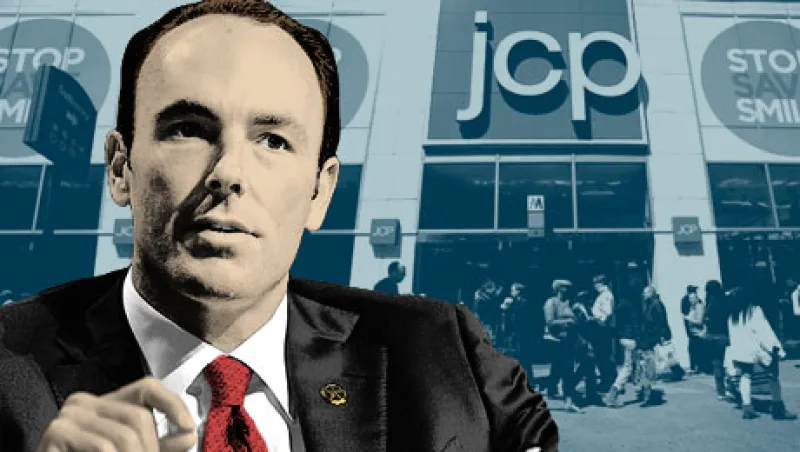Expectations for outsize gains on the downtrodden shares of J.C. Penney Co. purchased by major hedge fund firms have deflated like a punctured balloon.
In a September 19 interview with Institutional Investor, Kyle Bass, founder and principal of Dallas-based Hayman Capital Management, one of the hedge fund firms holding J.C. Penney equity, said, “We’re not investing in a turnaround. We’re investing in a stabilization.” Hayman has also taken a position in J.C. Penney’s debt, selling credit default swaps written against the company’s five-year bonds.
One week later, on September 26, hedge fund managers learned that their stakes in the Plano, Texas–based retailer would be diluted when J.C. Penney made the surprise announcement that it was issuing 84 million new shares, raising total shares outstanding to 220.6 million. The new equity issue, which priced on September 27, raised $785 million and diluted existing shareholders by 38 percent, sent J.C. Penney’s share price falling from $10.42 to below $8 a share. (It closed October 17 at $7.35.) By comparison, J.C. Penney shares were trading at more than $17 in July and nearly $27 a year ago.
“We were really frustrated. We didn’t believe they needed to raise the capital,” Bass said about J.C. Penney on CNBC on October 9. “Obviously it was not because they wanted to — but because the market was saying they wanted them to.”
The lineup of investors that bought large stakes in J.C. Penney during the past six months includes several widely followed hedge fund magnates. George Soros, chairman of Soros Fund Management, took a 7.9 percent stake on April 15, a week after J.C. Penney’s board fired CEO Ron Johnson and replaced him with his predecessor, Myron (Mike) Ullman. Johnson, who ran Apple’s hugely successful chain of retail stores, did away with J.C. Penney’s heavy reliance on discount coupons and sales pricing to lure customers.
The strategy drove away the department store chain’s existing customers and failed to lure in a significant number of new ones, sending the company into a tailspin. Soros supported J.C. Penney chairman Thomas Engibous and CEO Ullman in a bitter board battle with activist investor William Ackman, founder and CEO of hedge fund firm Pershing Square Capital Management. On August 27 Ackman sold Pershing Square’s entire position — 39 million shares, then an 18 percent stake — for $504 million at an estimated loss of $500 million. Other hedge fund managers stepped up to buy his shares, hoping to benefit from a rebound at the retailer. For its part, Hayman Capital snapped up 11.4 million shares of J.C. Penney, for a 5.2 percent stake. (Read more: “Bargain Hunting at J.C. Penney”)
Another Ullman ally, Larry Robbins, founder of New York–based hedge fund firm Glenview Capital Management, jumped in to buy a big chunk of Ackman’s shares. Glenview Capital more than doubled its holdings of J.C. Penney, to 20.1 million shares, and raised its stake from 3.4 percent to 9.1 percent. This makes Glenview the largest single shareholder in the retailer, even after the new equity issue.
Richard Perry, founder and president of New York–based Perry Corp., bought 3 million shares from a Citigroup secondary offering of Ackman’s shares, raising his hedge fund firm’s stake to 15 million shares, or 8.9 percent. After Johnson’s ouster from J.C. Penney earlier this year, Perry jumped to increase his position in the department store chain, buying 12 million shares, a 7.3 percent stake. (Recently, however, Perry did somewhat of an about-face, selling 9 million shares on September 30, leaving his firm’s stake in the retailer at 3.3 percent.)
Ackman’s ally Steven Roth, chairman of Vornado Realty Trust, a publicly traded real estate investment trust, resigned from the board of J.C. Penney on September 13 and revealed Vornado’s intention to sell all 13.4 million shares it owned. Roth, who had joined the board of J.C. Penney with Ackman in early 2011, sold 10 million shares of Vornado’s then 23.4 million-share stake in March. Vornado Realty’s losses on J.C. Penney may rival Ackman’s.
As the battle between Ackman and J.C. Penney played out over the summer, the cost of credit default swap protection on the company’s bonds rose sharply. Owners of J.C. Penney bonds feared they were facing an eminent default because rumors were swirling that commercial lender “CIT was backing away from J.C. Penney’s small vendors,” Bass said in his September 19 interview. J.C. Penney did not do a good job of handling public relations around the issue, he contends. “CIT was only backing away from a couple of small vendors that had their own problems,” Bass says. “They actually redoubled their efforts in supporting the big vendors at J.C. Penney.”
Market analysts are unsure whether the new equity issue is decisive for J.C. Penney’s prospects for a turnaround. The stock offering was preceded by a scathing report from Goldman Sachs Group credit analyst Kristen McDuffy, who issued an underperform rating and a recommendation that J.C. Penney bond holders buy protection against a possible default through credit default swaps. The report, however, assumed the future liquidity needs at J.C. Penney would be met by new debt issues and did not evaluate a scenario in which new funds would be raised by equity. (Goldman declined requests for an interview with McDuffy.) The credit report sent shares tumbling ahead of the equity offering.
Many analysts see the new equity issue as a counterweight to the deteriorating outlook for the retailer as the company burns through free cash flow faster than it predicted and consumer confidence ebbs. “It buys them a little bit of time,” says Rick Snyder, senior consumer retail analyst at New York–based securities firm Maxim Group, which downgraded the shares from a buy to a hold. “Perhaps the raise satisfies some constituents of theirs, such as vendors,” Snyder says, “but it certainly doesn’t do anything for shareholders.”
Some market observers believe that the struggling retailer did the right thing. “I do not think J.C. Penney would have issued the latest equity if they did not need the cash, and I do not think it was a large surprise to the market,” says Ken Murphy, senior vice president and portfolio manager at Standard Life Investments in Boston. “The action removes the near-term concerns the market had with liquidity, most likely until sometime in 2015.” Snyder, by contrast, is not convinced that J.C. Penney’s recent equity offering satisfies the company’s cash flow needs through the 2014 holiday shopping season.
Although a new equity issue would normally raise the outlook for a company’s debt holdings, the J.C. Penney debt picture deteriorated after its new issue. This was in part because the retailer announced at the time that it was burning through its cash reserves faster than anticipated. The company said it expected to have $1.3 billion in its credit facility by year-end, rather than the $1.5 billion forecast in August. This reforecast was especially painful given that J.C. Penney seemed adequately prepared for its liquidity needs in May, when it first entered into a $2.25 billion secured credit facility with Goldman Sachs using its 1,100 retail stores as collateral.
“Typically, when you have that type of equity infusion, it should be credit-enhancing,” says Monica Aggarwal, a debt analyst who covers J.C. Penney at Fitch Ratings, which on October 2 lowered its bond rating on the retailer from B-minus with a negative outlook to CCC. Aggarwal estimates the total cash burn in 2013 will hit $3 billion and that J.C. Penney will have $2 billion to $2.1 billion in liquidity at end-year 2013, leaving the retailer with a potential shortfall for the 2014 holiday shopping season.
Aggarwal contends that J.C. Penney will have to push its overall sales into the $13.5 billion range, a substantial improvement over 2013’s $12 billion. The company would also do well to expand its gross margin, presently stuck at 30 percent, back to around the 40 percent mark, according to Aggarwal. The need for additional cash will ultimately depend on J.C. Penney’s earnings before interest, taxes, depreciation and amortization. If the retailer needs more cash next year, Aggarwal expects that it “could come in the form of a convertible preferred type of debt.”
After the equity issue, Standard & Poor’s maintained J.C. Penney’s already low credit rating of CCC with a negative outlook. “It really reflects the view that the company’s performance over the past 15 months is one of the worst we have seen in recent history,” says David Kuntz, a credit analyst at S&P. “For a company to change its strategy of merchandising and product so drastically, and alienate its customer base without testing it with customers first, is sort of unheard-of.”
Kuntz recognizes that J.C. Penney is starting to hold steady, but S&P is maintaining its negative outlook because the company is not generating sufficient free cash flows to cover operations and capital expenditures. “Until that situation is resolved, that’s going to drive how we think about the company,” Kuntz says. Right now J.C. Penney is a long way from covering operations and capital expenditures, and that is unlikely to change for the next few quarters, according to Kuntz. The store’s fourth-quarter 2013 performance stands to be critical.
“If things substantially improve through the fourth quarter, it could buy them more time,” Kuntz says. He believes that big sales and coupon discounts can work again for J.C. Penney: “It’s working for Macy’s.”
The outlook for retail and for consumer confidence in general is weakening, according to Snyder at Maxim Group. “There’s nobody in the malls,” he says. That may explain in part why J.C. Penney decided to make the offer for new equity now rather than later, he explains. “The environment [for retailing] is bad out there.”
Jeff Cate, director of corporate fixed income at Hayman Capital, sees J.C. Penney’s stabilization as a possibility. “The reality is that the customer did not die,” he says. “The customer is just shopping somewhere else. We believe that by bringing back the promotional strategy, the marketing strategy, the proper merchandising, we can attract those customers back in relatively short order.”
Cate may be onto something. In September sales at J.C. Penney’s stores were down just 4 percent over the prior year and 5.8 percent higher than in August. September online sales increased 25.3 percent year-over-year. Experian Marketing Services credits J.C. Penney’s surge in back-to-school sales with helping the company take over the No. 2 online retail spot, behind Wal-Mart Stores and ahead of both Macy’s and Target. For hedge fund investors like Hayman’s ?Bass and Glenview’s Robbins, these improvements may help ease the sting from J.C. Penney’s recent equity offering.
Read more about equities.






